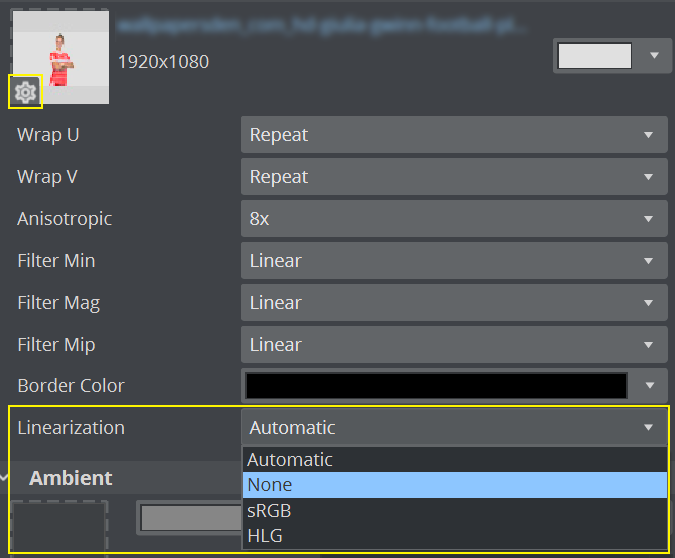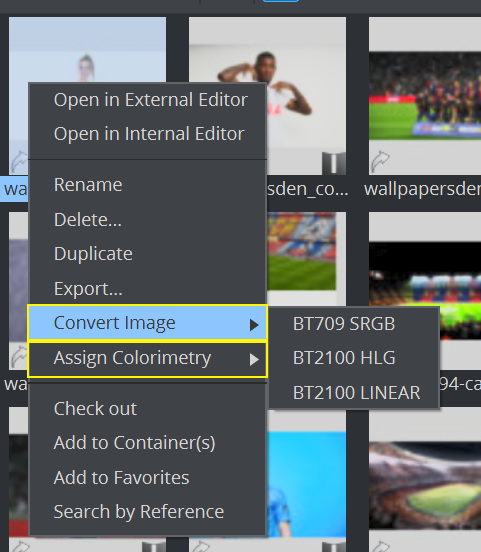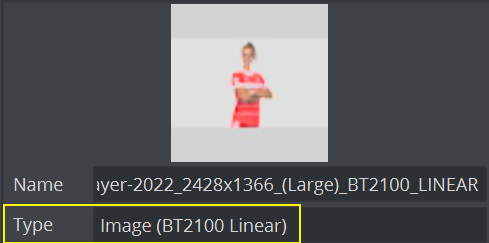To match the scene's color space, assets need to be converted from their given space, to the target/scene color space. Depending on the type of media, a few actions might be required to work correctly.
The input color space conversion needs to be active, preferably to Both:
Using Live Video
SDI/IP and NDI Sources
SDI/IP inputs with Matrox boards and NDI inputs, are fully supported in HDR workflows. They are converted between SDR and HLG, and the renderer selects the appropriate version of the input texture for the given use case.
The colorimetry of NDI inputs is determined based on NDI signal’s metadata. Signals with missing metadata are treated as SDR.
The only requirement to use (and send) NDI stream, is to set the in and output color depth to 16 bit. NDI streams deliver the required metadata to automatically set the correct color space.
Other live input types (for example, SDI inputs with AJA or Bluefish, SHM SMURF, WebRTC, etc.) are only supported in SDR scenes.
To use SDI or IP based sources, make sure the correct colorimetry is set in the config settings for your input source.
Miss matches between the configured colorimetry, lead to incorrect conversions.
Note: Input channels using hardware DVE on Matrox X.mio boards (SDI, IP, and Matrox Clip player), only work if the colorimetry of the input channel matches the output colorimetry.
Limitations:
S-Log3 (Rec 2020) is for backward compatibility only.
SDI/IP sources in DVE mode need to match the output colorimetry.
SDI or IP based HDR workflows are supported on Matrox boards only.
AUX Channels
AUX channels (used to exchange data with 3rd party renderers as Epics Unreal Engine), need to have the correct color space set in the in the Aux tab.
Clip Playback in HDR Workflows
HDR is supported by the Matrox clip player, VML clip player, and, for VER scenes, clip player texture renderer. As well as with supported live inputs, the textures are automatically converted, and the correct variant is chosen.
The Matrox clip player treats all opened clips as if they had the configured colorimetry. Loading a clip with a different colorimetry leads to incorrect results.
VML and clip player texture renderer use the metadata of the clip file instead. Clips with incorrect metadata are used incorrectly.
Matrox Clip Player
To use the Matrox clip player for HDR clip playback, the colorimetry needs to be set explicitly in the Viz Configuration:
Note: If you are using DVE inputs, the colorimetry needs to match the output colorimetry.
VML Clip Player
The VML based clip player can read the metadata of a clip, and set the color space accordingly. Therefore, the metadata within the clip needs to be set correctly.
Texture Clip Player
As the texture clip player is also using the VML clip player, metadata is being used to convert to the scenes color space.
Media Assets
Nested Channels - GFX Channels and Super Channels
GFX channels involving HDR, only work if an HDR scene is nested within another HDR scene, and the channel texture linearization method is manually set to HLG.
Note: Super Channels only work with SDR content within an SDR scene. HDR is not supported.
Mixing SDR and HDR content using super channels, is currently not supported.
Image Channels
Image channels do not perform conversions between SDR and HDR. They only work correctly if the image has the same colorimetry as the engine output, independent from the scene.
How to Work with Images in HDR
Images for HDR require at least a 10-bit per channel, often 12- or 16-bit floating-point, 8-bit formats (JPG, PNG) cannot represent HDR properly (banding and clipping occurs).
Images (or Textures) within any scene, are automatically linearized into the scene's color space, if they are located on Graphics Hub. This happens automatically while loading a scene, if the option Automatic Image Conversation in Viz Config, is enabled: .
As images require embedding metadata to interpret content correctly, images from other sources (a local file storage) might require a manual setting of the linearization method.
The linearization method can be set to sRGB or HLG within the texture options of several plugins (PBR, Phong, Texture Slot, etc.).
You can also reassign the colorimetry on existing images, or convert images from one color space to another. In Asset view, right click on an image to either re-assign, or convert to a different color space.
Images with correct metadata for HDR are labelled in Asset view, and more details are shown in the properties panel:
Info: To provide a fallback to SDR versions, you need to tone-map HDR images (to avoid clipping or washed-out colors).
JPEG XL Image Support
To utilize the full color space, we recommend using JPEG XL images. JPEG XL is a modern image format supporting wide color gamut, HDR color space, and also supports alpha transparency. Viz Engine 5.4 and later allow to natively import JPEG XL files (.jxl files). These files can be created (or converted) for instance on Photoshop v26.8 and later.
Info: .exr and .hdr images, are used for environment maps rendering only.
References: https://jpegxl.info/









